Black Flag Catalyst
The Black Flag Catalyst Protest Guide v1.2
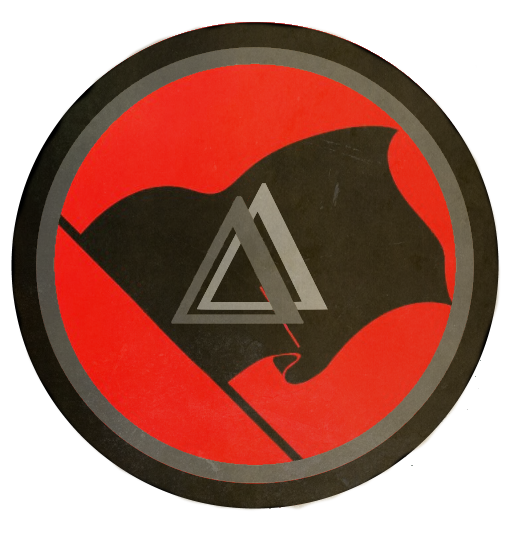
The following resource is intended to be a guide for those who want to participate in protests, including tactics for both militant and pacifistic action. The goal of this guide is to compile the knowledge from the various insurrections across the planet and turn them into a single resource which can be given to anyone and to inform that person on their place in the action.
For this reason, we will include both peaceful and non-peaceful tactics within this guide. If we are to learn from the successful movements of the past, we can see that all successful pressure has been the collusion of the peaceful and non-peaceful aspects of the movement, such that the peaceful party can lobby the state to concede, saying to them “now see? Wouldn’t you rather deal with me than them? Sit down and make some concessions to those suffering people.” Meanwhile, the non-peaceful protesters escalate the aggression of their actions such as to put a clock on the state. Direct action should therefore not be seen as a chaotic byproduct to be avoided. It should instead be seen as a necessity as to extract outcomes for the movement. Ultimately, if the demands of the protests are not met, revolution should be the threat. In this way, we are to transform the government to our whims, not vise versa.
Preparation and Coordination
Firstly, before we get started, what should you bring to a protest? This will vary depending on what your role is, obviously, but there are a few things that will serve you well no matter what role you are filling. The items listed below are recommended for everyone, if they are able to get access.
What to wear:
-
Non-descript, solid color, layered cothing that will cover identifying tattoos
-
Goggles and a mask
-
Emergency contacts written on skin
-
Tie your hair up, but not on top. Bundle tightly.
-
Heat resistant gloves
-
Head protection
-
Elbow and knee guards
-
Comfortable shoes
-
A fanny pack or lightweight backpack
-
A gas mask
What to bring:
-
A squirt top water bottle for drinking and to put out tear gas
-
Snacks
-
Cash/change
-
ID
-
Washcloth
-
Ear plugs
-
Bandages or first aid supplies
Do NOT bring:
-
Jewelry
-
Illegal paraphenalia
-
Contact lenses
It is recommended that you not bring your phone to the protest or turn off your phone unless you have taken proper precautions. Police can use all data transfers as a way to permanently track your movements. For this reason, it can be a good idea to use a burner phone. Do not activate it at your home, or its history will begin there and defeat the purpose. Activate it somewhere public or close to the protest.
It is highly recommended that you develop trust networks before and during the proests. This includes not only protest buddies, who will be with you at all times and with whom you should try not to split up, but also groups of trusted individuals. In order to form trust networks with new allies, communicate feelings of trust or doubt about other protesters only within groups you can control, reach an agreement on their trustworthiness, and only then communicate that agreement outside the group. Do not diminish trust with others just because they are using different tactics than you are.
Protest buddies should be used to make sure you are safe. A good model for coordination, especially if you have quite a few people in your larger party is to separate them into groups based on their willingness to escalate. Those who want only pacifist protest go in one group, those who would clash with the police in another, those who would engage in property destruction or graffiti in another. This is so that the tactics of the groups do not conflict with one another and so that those who would be willing to escalate do not get those who would not in trouble with their actions.
Broader coordination is also highly recommended. A person who is offsite of the protest who is monitoring the protests, coordinating legal resources, communicating messages between groups, and so on... can be invaluable. In order to minimize the need for protesters in each group to constantly be monitoring and coordinating, it can also be a good idea to choose one representative for each of the groups, sometimes called a spoke, to communicate with the offsite asset and with the other groups.
Also, try to communicate safe areas and regrouping zones with protesters in your trust networks. This will allow, if your protest is split or diffused, for everyone you know to return to a particular area where you can all regroup and decide how to move forward. Be smart in choosing these areas. You want them to be close enough to the planned protest that they can be accessed by your allies, but not so close that they are likely to be consumed by the protest, and in a place that is just private enough that it serves as a means of escape and cover when fleeing from state enforcement.
Civil Disobedience and Protest
Do not think that the presence of militant tactics in this guide is meant to suggest to you that you are not useful to the movement if you only choose pacifism. Mass pacifist tactics will always be useful and even necessary to a successful insurrection and have always served as an integral means of popular pressure. Let us discuss some of the most important ways that civil disobedience plays a role in mass protest.
One of the most important jobs of the civil disobedient, is documenting the protests and the treatment of protesters by the state. However, in order for you to help more than harm, you must be careful not to document the faces or other identifiable traits of protesters. Not only does this allow police to document and identify who was at a protest and thus press charges at a later date, it also may serve as a means of doxing protesters identities to White Supremacists or other violent fascists. Thus if you want to document the protests, please be aware of the importance of your safeguarding the identity of everyone present. If you are going to film video which will have protesters’ faces in them download apps that obscure them before posting pictures or video to social media.
Quite the opposite of this tip, in terms of filming, is to film the agents of the state; whether police, military, or otherwise, as much as conceivably possible. For the same reasons that we should not want our protesters’ identities recorded, we should want the faces and actions of the state documented as much as conceivably possible. This way we will be able to pressure them and call them to task at a later date as well as create outrage in the public.
If you are not filming, consider leaving your mobile phone at home or at least turn it off. There is now technology which can use your phone as a means to track you and the protest broadly.
Pacifistic protesters can also be very useful in amplifying the voices of others. This technique is often called the human megaphone and it utilizes callbacks. The first person will shout “MIC CHECK!” and the people will decide to amplify the message or not based on whether they shout back “MIC CHECK” in unison. There may be a few rounds of “MIC CHECK” going back and forth to make certain that everyone is in unison together. After this has been achieved, the person who originally mic check’d will speak in short, easy to repeat statements “THESE ARE!” (“THESE ARE!!!”) “OUR STREETS!” (“OUR STREETS!!!”) “MOVE BACK!” (“MOVE BACK!!!”) The more protesters are present, the louder these mic checks can become.
Another reason why pacifist protesters are helpful is because they provide numbers. Even those who might flee when the clashes begin, only to rejoin shortly after, are helpful. Having large numbers of people turns crowds into intimidating things and requires a proportionate ability to suppress by the state. In this way, because it is more and more difficult for the state to dominate the protests the larger they become, the very presence of human beings decreases the tendency that clashes should take place to begin with, turning the tables in favor of the masses as they choose to act.
The usage of human bodies to blockade or otherwise control areas, is a major part of what any protest comprises of. For this reason, it is important that, when numbers are present, they have a good idea of how to act, how to place themselves where they are needed, and how their movement and presence affects the reactions by officers of the state.
Ideally, for optimum ability to exert pressure, crowds should stay a little more than shoulder width apart. This can allow the crowd to act in a more even and concerted fashion on the front and also allows some usage of diversive tactics.
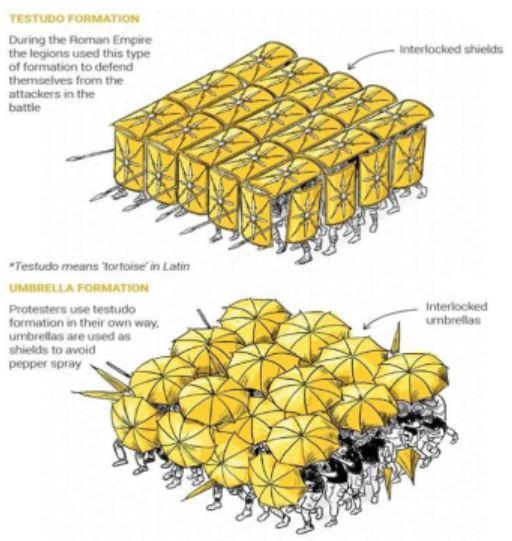
However, this can be a very stressful environment for protesters and will therefore often not take place. By default, protesters will have a tendency to spread out somewhat, when space permits. This has the effect of controlling more space and therefore extending the size and presence of protests. But it can leave them very vulnerable to being split or suppressed easily by small numbers of police.
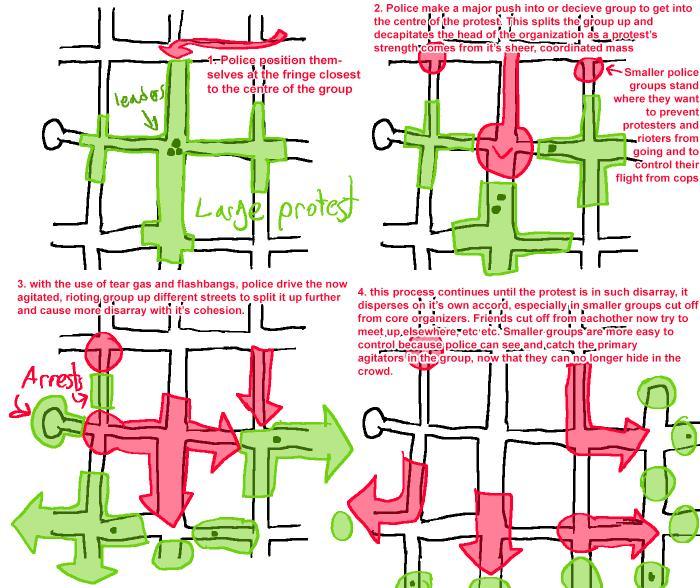
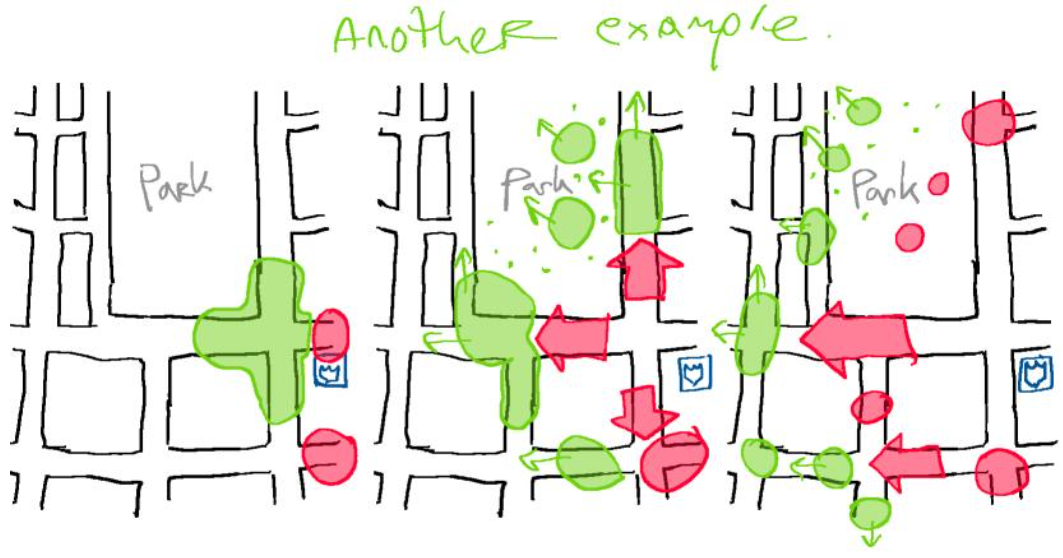
Be careful that the direction you are moving does not start the crowd down the wrong path. As best as possible stay as one cohesive group and resist being split. Be aware of how your movements will send a message to other protesters. When the time comes that there are clashes with the police, if you are just behind the frontlines, do not push your allies into police lines, but cushion them from being pushed back as they resist. Further, if they are hurt or they need to move back, be ready to recover them and fill the line. This is why only those who are ready to confront the state oppressors should be close to the front line. If you wish to stay peaceful, stay considerably back from the layers of people who stand face to face with the police.
The state is NOT YOUR ALLY. Never trust orders from police or military. Any agreement made with them should be treated as false until it is demonstrated otherwise. Never plan around any agreement made with police, except to give them room to demonstrate adherence. If police choose to defy agreements, ignore previous agreements immediately and return to previous tactics.
There is a very good chance, if you clash with the police, that they will then use “non-lethal” techniques such as rubber bullets, pepper spray, tear gas, and pepper spray balls to suppress or defray the crowd. All of these techniques can be lethal in certain scenarios and none should be taken lightly. You can withstand serious wounds from rubber bullets even if they do not hit you in the head, where they can do life-threatening damage including disfiguration and permanent blinding.
There are ways, however, of staying safe. First, if there are those who have made shields, be aware of their placement. Keeping those with shields between you and the police is one of the best ways to avoid being hit with rubber bullets or pepper spray.
If teargas comes into your area, there are a few things you can do. First, if you have a gasmask or other face covering, stay calm. You are best oriented to act quickly and stop it from harming others. If you have a bottle with a squirt top you can sometimes stop the teargas by spraying water on it. Better, if you see a traffic cone of almost any size, it can serve as a means to suffocate the tear gas grenade and allow you more time to spray it with water. If done successfully, it can completely snuff out the canister. If you are not wearing a mask or respirator do NOT inhale or stay in the midst of the tear gas for extended time. While it is rare it will do serious, lasting damage, it can put you out of commission quite quickly and extended exposure can indeed lead to lung distress and even miscarriage.
Let us also discuss the tactics that can be used in the occasion that police are using flashbangs. Firstly, although flashbangs are not meant to cause physical damage, they can do serious physical harm and even kill people as they launch shrapnel into the surrounding area. However, their main purpose is to disorient and subdue protesters through sound and light. In order to prevent this, close your eyes when you see flashbangs being deployed and put your hands over your ears. If you only have one hand, cover whichever is closer. It is recommended you do not put your fingers in your ears, because this may be unsanitary. If you have earplugs, put them in as soon as you see flashbangs are being deployed. Lastly, open your mouth. There is a concussive wave that comes along with flashbangs and this simple action can reduce the pressure inside your head, keeping you oriented. Lastly, crouch low and watch your balance. The combination of loud noise and bright light can easily knock you from your feet and if you happen to fall, staying low will keep you safe.
If you would like to become a dedicated medic in your protests, it is highly recommended that you read Riot Medicine. Do not over-step your bounds in attempting to become a dedicated medic unless you have read the resources needed to ensure you can do the task properly. Otherwise you may put peoples’ health at risk.
You can also be a great help as a legal observer and in staying safe to coordinate bail and legal resources for protesters. Documenting abuse while not putting it on social media can be very helpful for those trying to fight conviction. Further, giving people numbers for ACLU and NLG attorneys, as well as other organizations who will coordinate bail, could mean the difference between protesters spending large amounts of time in jail or having their freedom.
Another aspect of being a civil disobedient is controlling the narrative. This can be one of the most challenging things to do when there are masses of people. Disapproval with tactics of fellow protesters should never be communicated with journalists or outside sources. All discussion of tactics (approval or disapproval) should be kept inside protest groups. If asked about your approval or disapproval of certain tactics with those outside the protests, only ever communicate that their actions are valid responses to the events taking place. When you spend your time criticizing fellow protesters, you only validate the worries of people on the outside. Demonstrating solidarity with the actions of your fellow disobedients is a way to control what is reported and shows the seriousness of the issues at hand. Take a tip from the radical Mexican feminist movement. They chant “WE ALL DID IT” in response to any and all acts of vandalism.
If you are not prepared to talk on camera or you feel you may say something you do not intend, please allow others to speak with reporters. Journalists have long had a tendency to choose the clips which cast protests in the worst light, especially focusing upon interviews which use ableist biases to present protesters as irrational or mentally ill.
Also attempt to avoid meaningless gestures. Ask yourself what impact your actions will have. Only ever use symbolic gestures if they are being filmed. Deny the state any opportunity to use symbolic gestures. We have seen, for example, police taking a knee during the 2020 revolts in order to show solidarity with the movement and being filmed as some sort of inspirational story, just to turn around and launch tear gas into the protesters moments later when cameras have been turned off. Accept only meaningful concession, diffuse any attempt they make to control the narrative.
Militant Tactics
We now reach the section on how to place active pressure on the state. This section provides tips on how protesters may clash with the police and use property destruction. It must be said, all escalation should be done carefully and should consider what message will be sent. Rule #1 is do not escalate further than state forces unless you are prepared for them to respond in kind. Said otherwise: only ever escalate to a level of violence you are prepared to receive. Further, note that many of the following tactics should be practiced with those in your trust network ahead of time. If you are aware you will be attending a protest where confrontation might arise, coordinate at least some rudimentary training with those who will be on the frontlines with you.
One of the simplest forms of non-peaceful resistance is to prevent police from moving through an area by force. If the police are armed with batons and riot shields, it can often be practical to stop them from taking an area, especially if you have protesters armed with shields and body protection. As has been said above, densely packed formations are ideal for these scenarios, but do not pack in too densely or there will be no room to maneuver or recover allies from the frontlines. The ideal of this tactic is not to actively harm the police, but instead to prevent them from moving. It can be a very good way to use your superior numbers to distract the inferior numbers of the police with a stalemate while the protest proceeds elsewhere or takes up room that the police cannot control.
Another way, short of clash with the police, of preventing from doing their job is the use of high powered lasers and paint. Both of these are used to blind officers by obscuring their vision. Lasers will make it very challenging for officers to look in the direction you are shining them, disorienting them, and possibly even causing permanent damage if they do not look away. They can also be used from a very long distance, meaning that the police will have a very challenging time stopping you from using them. The more people with these lasers the better, because then the police will be unable to root out all of the users. Paint can be useful in a similar way in order to obscure the visors of the riot police.
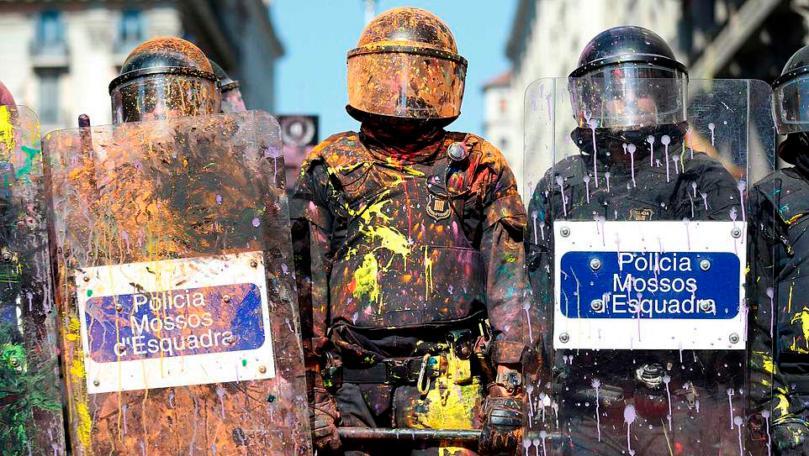
It is recommended that one only rely on spraypaint if they plan on being on the frontlines. Otherwise, if protesters are engaging with the police at a distance, they should use small buckets of paint, as seen above. This paint is also more likely to adhere and form a consistent layer over the visor or riot shield which will prevent the riot police from seeing, forcing them to raise their visors or lower their shield and thus place themselves at risk.
If you plan on confronting police in a militant manner, it is recommended you only ever do so if you have training, if their numbers are far inferior, and if they are not well armed. It is also recommended that anyone on front lines armor themselves as much as possible. Even bicycle or paintball gear can be enough to keep you safe and those from LARPing communities often know how to build cheap and very resilient gear, including makeshift riot shields. Do not be afraid to reach out to people who know how to make this gear ahead of time, even if you plan on being safe, as you may not get to choose where you are in the crowd.
Another aspect of engaging in a non-peaceful manner, is being fearless in de-arresting allies when officers have gotten ahold of them. If officers are trying to pull a protester from the crowd, grab hold of the protester and then have others grab ahold of you and pull them back. The only means an officer has of punishing protesters aside from violence, is to physically remove them. Disallowing fellow protesters from being removed from the crowd is the same as freeing someone from jail, paying their bail, and expunging all charges.
You may also be surprised to see how lax officers are with arrested protesters, often being unable to manage the numbers they have gathered and leaving them unattended for periods of time. If you find protesters who have been zip-tied, you can place a thin object between the track and the band and this will often allow you to loosen the ties and free arrestees.
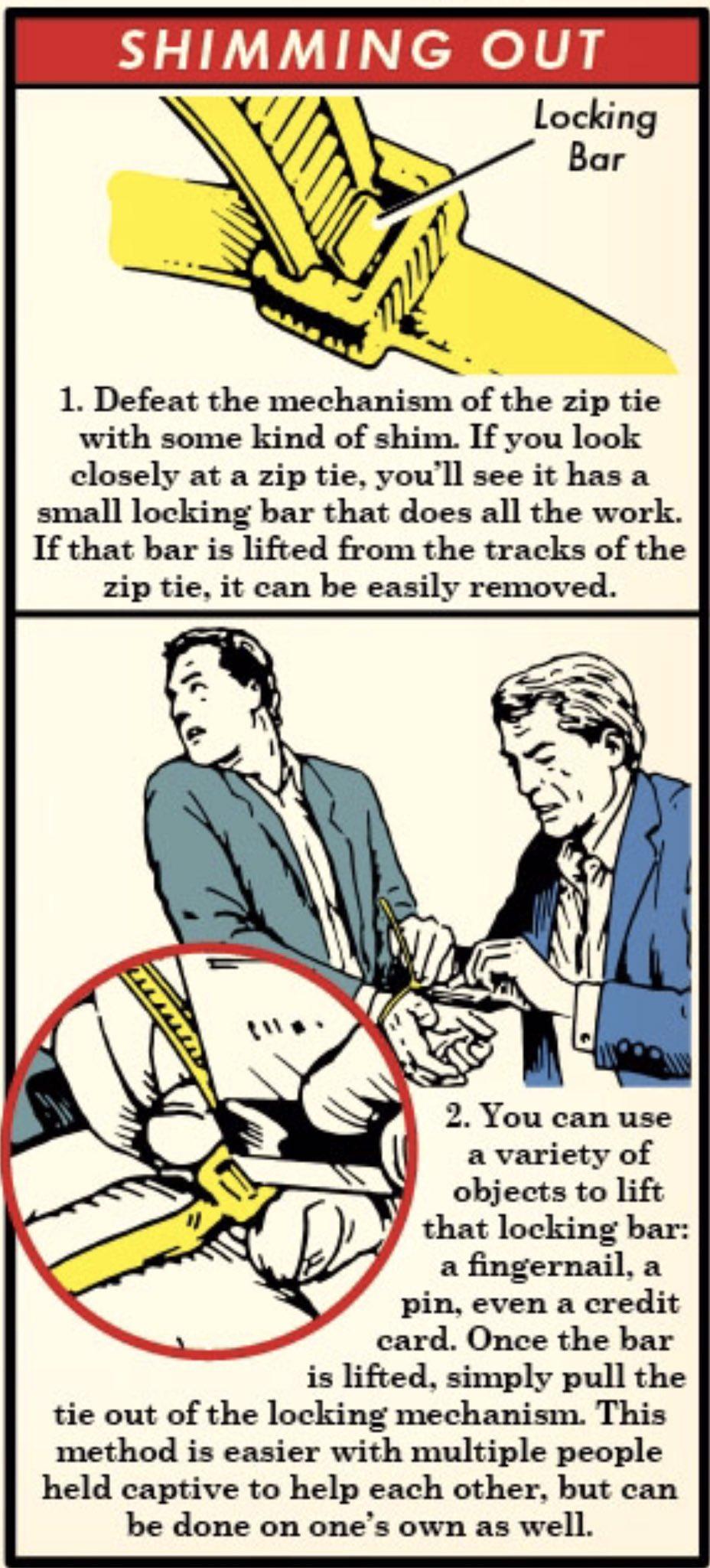
If you are arrested with zip-ties or cuffs, when they are wrapping them around your wrists, flex your wrists. Officers will clamp down very tightly when they affix them, making it uncomfortable and disallowing you from wriggling out. However, if you flex your wrists, you expand the size of your wrists, allowing you to un-flex afterwards and thus possibly get your wrists free.
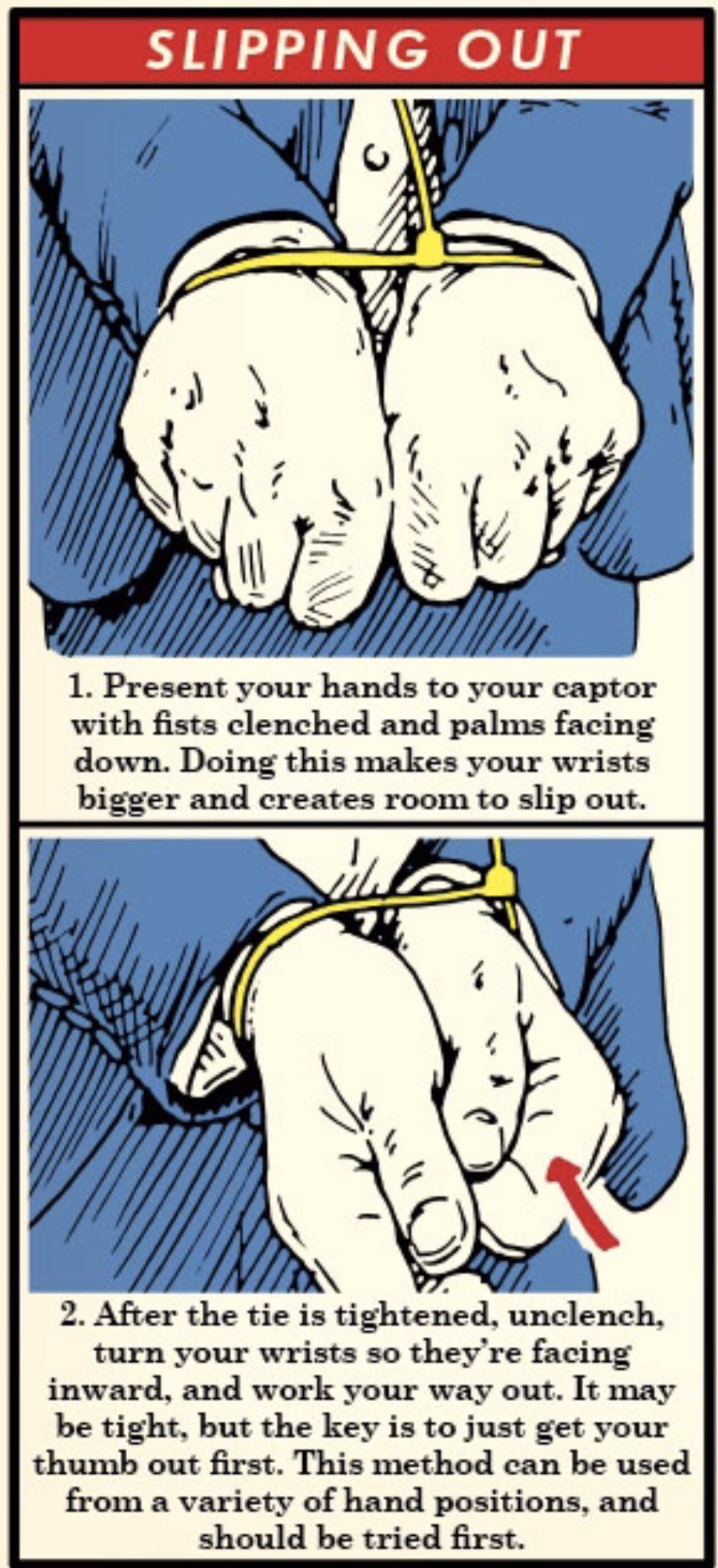
Another approach to clashing with the police is to keep distance and use projectiles such as bricks, bottles, and so on... This has very small change of doing permanent physical damage to officers, especially if they are in riot gear, but it does have the effect of defraying, confusing, and often forcing retreat. The greater the number of projectiles used, the greater the chance that the police will cease the clash until they can escalate to the usage of “non-lethal” munitions.
We now move on to the usage of property destruction. This is seen as one of the quintessential tools of the rioter. Burning a building, a car, or other piece of property, is a multi-faceted tactic and has ups and downs. First, it is recommended that you choose targets which represent the enemies of the movement. The 2020 insurrections have garnered majority support in the burning of the Minneapolis Police Department and there is next to no outcry of the destruction and looting of large chain corporations, but there has been less public support for small business destruction. However, this is not to invalidate the choosing of these targets. One of the primary purposes of property destruction is to place pressure on power structures and a flagging economy is always a means of pressure on the forces of capital.
When choosing targets for property damage, be certain that you loot as many of the useful materials within the building as possible. Try to focus on looting items which can be redistributed to comrades and provide real material aid. This is not to pass judgment on any act of looting. But try to connect the act of looting with principles of mutual aid, not simple personal benefit. This allows the movement to continue for longer, as these expropriated goods can then be used to sustain other protesters and thus counter-act the real material damage that may be done to their personal solvency by taking place in these protests.
If you have moved to the point where your protests have become so radical as to seize areas of the city in a permanent fashion, it may be very useful to create blockades of various kinds. This is not only to include the traditional blockade, as we have seen throughout history, in the form of piled up rubble. It is also to include more modern methods of preventing vehicle entrance. Below can be seen how effective clingwrap is, when wrapped between two poles, in stopping even very large vehicles from passing. So long as the vehicles do not have tread, there is little chance they will be able to move through these cheap and effective clingwrap barriers.
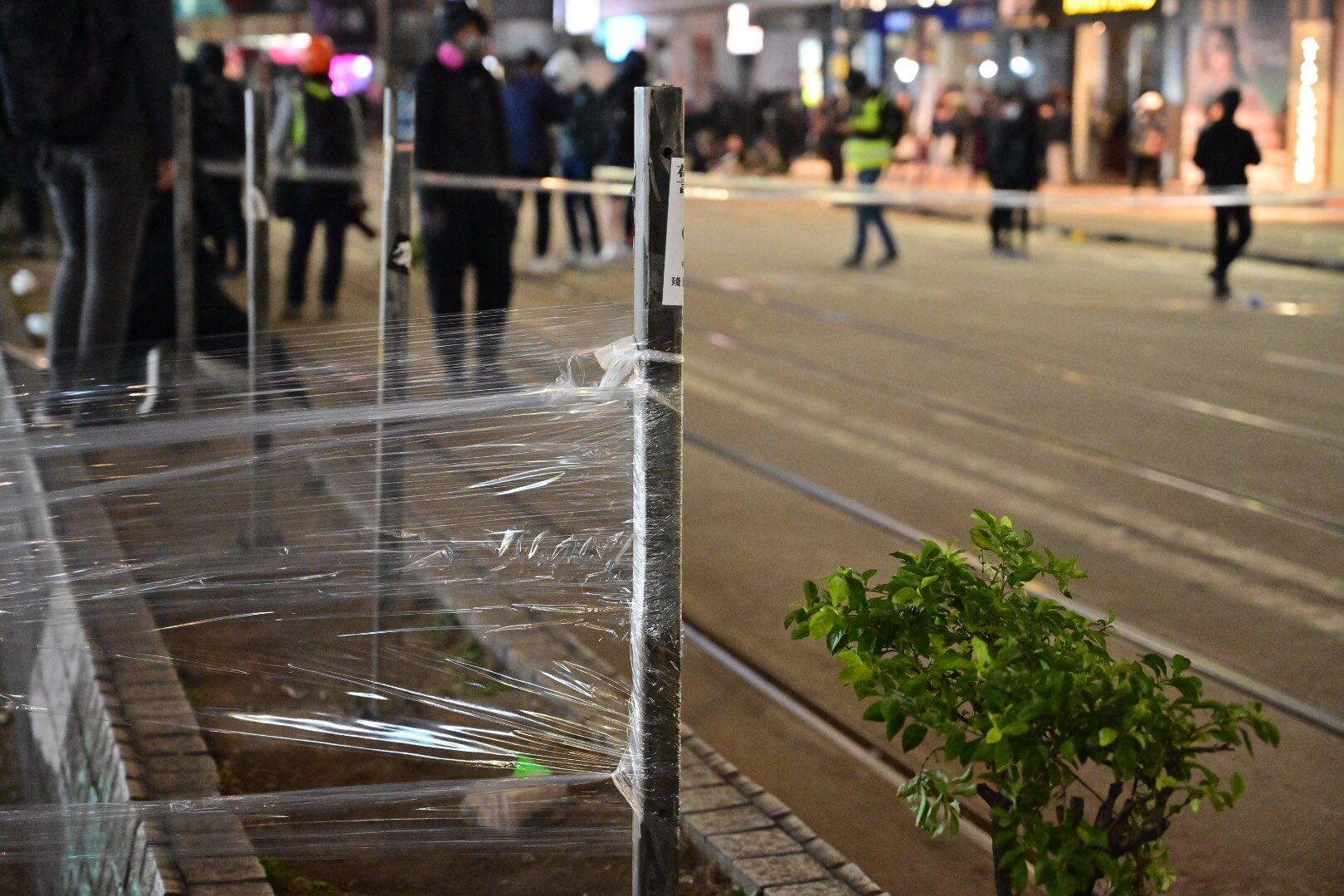
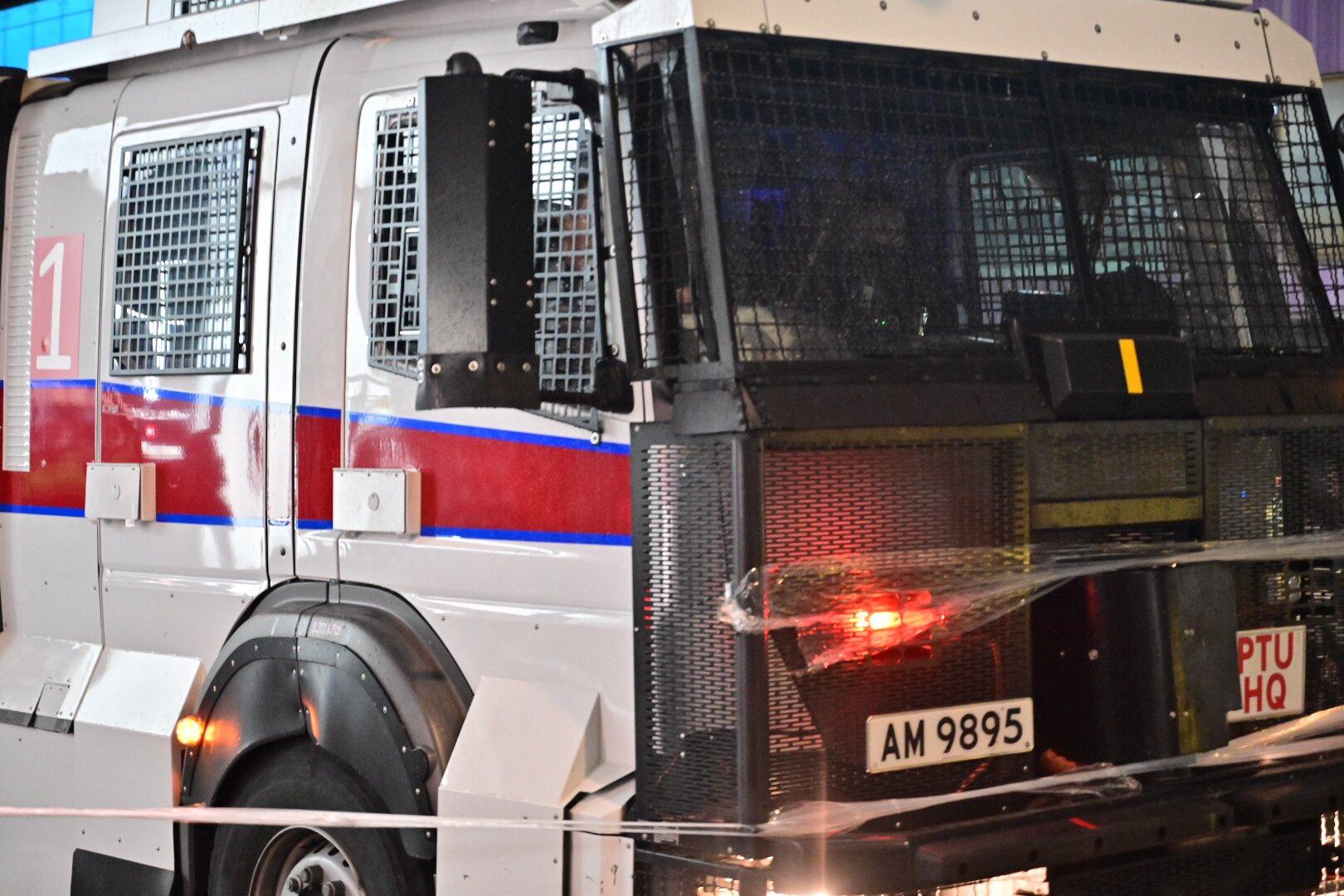
Protest Democracy
If your protests achieve a level of success that they exist for an extended period of time, they will often have the opportunity to become more coordinated. Those in positions of respect will often be looked to to decide what sort of tactics will and will not be allowed proceeding forward. However, this is a dangerous thing to do. The state has become very good at suppressing leaders and infiltrating hierarchical structures. It is much harder, however, for the state to infiltrate flatter and more democratic bodies.
This is why protesters should create horizontal council structures where consensus decides future action. These horizontal council bodies will not sideline organic leaders; they will merely remove their power to decide for everyone else. Indeed, if one wants to create a council body, one of the most effective first steps is to locate an organic leader and then convince them that decisions should be made through the democratic body instead.
There are many kinds of councils which can be built, outside of protests, during protests, and even enduring afterwards. Some examples are listed below, from Let Your Motto Be Resistance by Kali Akuno:
Formations
In addition to building progressive and revolutionary organizations that address multiple issues, like the New Afrikan United Fronts, or multi-national People’s Fronts, we must also build independent organizations that address specific self-defense needs:
Block Committee’s — These Self-Defense units on the level of an urban or suburban block and/or street should be the foundation of all our efforts. This type of organizing entails building deep relationships with our neighbors and their families, identifying mutual interests, and building clear lines of communication.
Neighborhood Councils — These Councils are scaled up extensions of the Block Committee’s, that unite several Block Committees into a joint structure that addresses the shared interests and needs of the community, including addressing complaints against the police or the government in general and resolving disputes within the community itself.
City Councils — These Councils are scaled up extensions of the Neighborhood Committees that serve to unite the strategies and activities of New Afrikan forces throughout a city. Elders Councils — These Councils are composed of respected elders in a community that are organized primarily to offer advice on strategies of engagement with the state (particularly the police) and mediate intra-communal contradictions and disputes amongst the people.
Youth Councils — Youth Councils are safe spaces for youth to assemble to both resolve their own issues and disputes and to formulate their issues and concerns relative to the health and well being of the larger community
Survivors or Family Councils — These Councils are composed of the victims of police violence, including the family members of those who were killed by the police or other law enforcement agencies. These Councils represent the interests of the victims to the community and should take the lead in the formulation of demands on the government, and the strategies and tactics that will be employed to attain justice.
Women’s Councils — These Councils are safe spaces for women to organize themselves to address their specific needs and issues. One of its primary functions will be to address issues of abuse and/or violence (domestic violence, assaults, rape, etc.) committed against women either by the police or other government agencies or by men in the community, including determining processes of rectification and healing.
People’s Assemblies — The Assemblies are designed to be dual power instruments that serve as direct vehicles of People’s Power. These Assemblies would be called to develop and institute autonomous solutions to various social issues and contradictions and to develop and advance various demands on the state.
People’s Tribunals — These Tribunals are extensions of the Elder Councils, City Councils, or People’s Assemblies and are communal spaces to gather evidence regarding police brutality and state repression to shape a People’s response to these crimes against humanity to secure justice through the administration of Peoples Power via boycotts, divestment measures, and various types of sanctions that bring the state and capital to heel or transform them altogether.
Copwatch — These are collectives drawn from our independent organizations and the various suggested committees that focus on monitoring the police and other law enforcement agencies operating in our communities, documenting their activities, and when necessary, intervening to prevent state abuses and repression. Copwatch initiatives should also provide various types of self-defense and security trainings, including “know your rights” trainings, and political education for the community.
Security Teams — These are units that should be developed from our independent organizations and the aforementioned committees to secure our communities from various threats at public gatherings and events, to respond to forces that pose threats to the community, and to respond to social and natural crises that confront the community
Militias — Are in part extensions of our Security Teams, and serve similar social purposes. However, unlike the Security Teams they are organized more explicitly to educate and train the community in the arts of self-defense, defensive fortifications, and military operations. The other major function of the Militia should be to respond to major crisis like the floods in New Orleans after Hurricane Katrina and the rebellion in Oakland, CA following the murder of Oscar Grant., to make sure our people’s safety is secure and that the state is not abusing our people
Emergency Social Response Teams — These Teams should respond to social crisis such as that posed by Hurricane Katrina, to make sure that in the midst of a crisis that our people are physically safe, treated with dignity, have food to eat, clean water to drink, are medically treated and provided with adequate housing. These Teams should be prepared to set up autonomous clinics and other emergency response operations following a catastrophe, like the Common Ground Collective and Peoples’ Hurricane Relief Fund in New Orleans after Hurricane Katrina, or Occupy Wall Street after Superstorm Sandy in New York City.
All of the formations mentioned above are intended to be the essential building blocks and/or components of the New Afrikan or Peoples’ Self-Defense Networks. These are ideal structures. Which ones you will be able to build in your community and cities will depend on the state of your community’s collective will and capacities to act. And further, our will and capacity, however inexhaustible, will be shaped by structural dynamics, in particular the social conditions and social histories in each community, city, state, etc. What we have offered in this handbook are mere suggestions and/or guides to establish a firm foundation for this protracted work based on the best examples drawn from our peoples’ history of revolutionary struggle and examples from revolutionary movements around the world.
These council bodies have many different purposes, as can be seen. Firstly, they create a way to arrive on agreement on tactics. Lack of agreement on tactics leads to a confused mass working on conflicting principles.Another one of the most important is that they provide a form of mediation for disputes. Do not let internal disputes get out of hand. When two parties are having a dispute, find a neutral party to act as a mediator. This mediator should be agreed to by both of the people who are in the dispute and after the mediator hears the difficulties of both sides, they should offer a path toward remuneration and rehabilitation for those who are involved. Above all, deal with these disputes in a civil fashion. Fury is for the state.
It is recommended, if numbers are relatively small in the council you form, that full consensus be sought. That is to say, vote and negotiate on measures until the only votes remaining are only “yay”s and “abstains.” This is most recommended, because it means that all concerns are brought to the table and dealt with and that everyone who is present actually believes in the action. No one’s views are discarded or marginalized. An example consensus model might work like this:
-
A resolution is presented by an individual in the democratic body. Following this, there is a discussion period about the resolution. After this discussion has concluded, the voters all place their first votes as a temperature check and the results are tallied. If the first vote is unanimous, the measure is passed and planning will begin.
-
If not, those who voted against the measure are asked to qualify their concerns into deal-breakers or non-deal-breakers. Those who have said that their grievances are not deal-breakers put their complaints into one of several categories and each category of complaint elects a delegate to plead their case.
-
After these delegates have each plead their case, voters are asked to weigh in on their agreement with the grievance and those with the grievance offer amendments that, if instituted, would garner their support. These friendly amendments are then voted on and a temperature check is taken to re-assess the status of consensus. If there is a unanimous vote, the motion is passed and planning will begin.
-
If not, those who said that their grievance was a complete deal-breaker are asked to categorize their complaints and elect delegates to plead their case. Voters are then asked to weigh in on their agreement with these grievances and more amendments are gathered. If, after all amendments have been passed, turned down, or sustained, and the vote is unanimous, the motion is passed and planning will begin.
-
Otherwise, the motion is tabled or dismissed.
The delegates mentioned here should be revocable at the whim of the council. They are not representatives in the sense of modern democracies; they are only given the power to carry through on the exact mandate that was stipulated when they were made delegates. If the council votes and reaches consensus that someone they have delegated to a duty does not meet their standards or desires, they can simply remove the delegate and then either replace them or scrap the need for that delegate.
Consensus can be difficult to manage when numbers grow due to the differences in needs, beliefs, and desires of those involved. If your council begins to grow too large to make decisions by consensus, you generally have two options:
Option 1 is to split into smaller full consensus councils and then maintain what is called a Spokes Council. This new Spokes Council will be numbered by delegated members from the smaller councils called Spokes, which bring word of proposals in the Spokes Council back to their smaller Community Council, then have them reach a vote, then return to the Spokes Council to vote as their Community has voted.
Option 2 is to weaken the consensus that is needed into what is called a Weak Consensus model. In such a model, if you cannot reach absolute consensus, you fallback to a 2/3 vote to settle and move forward, while maintaining an accountability process by the minority. We will lay out how such a weak consensus might work.
-
A resolution is presented by an individual in the democratic body. Following this, there is a discussion period about the resolution. After this discussion has concluded, the voters all place their first votes as a temperature check and the results are tallied. If the first vote comes to a 90% majority, the measure is passed and planning will begin.
-
If not, those who voted against the measure are asked to qualify their concerns into deal-breakers or non-deal-breakers. Those who have said that their grievances are not deal-breakers put their complaints into one of several categories and each category of complaint elects a delegate to plead their case.
-
After these delegates have each plead their case, voters are asked to weigh in on their agreement with the grievance and those with the grievance offer amendments that, if instituted, would garner their support. These friendly amendments are then voted on and a temperature check is taken to re-assess the status of consensus. If majority has now reached 90%, the motion is passed and planning will begin.
-
If not, those who said that their grievance was a complete deal-breaker are asked to categorize their complaints and elect delegates to plead their case. Voters are then asked to weigh in on their agreement with these grievances and more amendments are gathered. If, after all amendments have been passed, turned down, or sustained, the majority has now reached 2/3, the motion is passed and planning will begin.
-
After passage, the minority enters into a contention process during the planning phase of the resolution, such that they might still have some recourse before the resolution is fully implemented. If, during this contention phase, the majority drops below 50%, the resolution is tabled or dismissed.
-
However, if the minority can’t reach a simple majority during planning and implementation, the resolution is carried forward. The body now elects a delegate or numerous delegates to carry out the implementation of the measure under the strict mandate of what was contained in it.
-
Otherwise, the motion is tabled or dismissed.
Above all else, avoid formal leadership or centralization. Organic leaders should never be given formal power. Avoid all cults of personality. Convince all organic leaders to dissolve their power to the councils. Those with formal positions of power are not strengths, they are liabilities. Any that remain will become a threat either during the protests or in whatever remains of the movement after the protests cease. It is not that it is bad to trust to the expertise of others, it is that they should be given the power to domineer you. If they are truly organic leaders, then their suggestions will surely be held up by consensus or 2/3 majorities and they can then be delegated to carry out the tasks that leadership would have been given anyway!
See these protests as an opportunity to build the new world. In absence of the state, we must create the bodies of solidarity and consensus which will solve the problems of this world.
Autonomy and Revolt
When a protest campaign proceeds for a long period of time, planning can enter into strategy instead of simple tactics. That is to say, the choice of how the protest will proceed in response to the broader approach of the police can become important. How do you choose whether to escalate or de-escalate? When is it important to focus on clashes with the state and when should you work to build protest democracy? The general rule is as following, although it should not be taken as ironclad: when the state escalates, focus on the clashes. When the state de-escalates or stalls their tactics, begin building.
One of the most useful things that can be done in de-escalation or static phases, is to create autonomous areas. That is to say, when the police have begun to respond with static tactics, so long as you have learned to respond, you should create permanent staging grounds in strategic areas which are close to your frontlines. The first priority of setting up these staging areas is to create a permanent autonomous zone wherein the police cannot enter. Barricades, as described earlier, can serve as a means to enforce this autonomy, but also placing your militants at these locations as to maintain autonomy from police, may be required.
These staging areas can serve numerous purposes. First, they serve as a place wherein protesters can be safe before and after protests, as well as places for protesters to sleep and receive medical care, distribute food and water, and so on. Further, they should be made into cultural hubs. There is no reason that occupation here should be a purely military affair. Do not be afraid to let bands perform or enjoy yourselves. However, beware ever letting these activities distract you from your purpose.
These autonomous regions are also the area wherein it is best to practice protest democracy, because they are under less surveillance by police. Their existence will, however, also very likely escalate tensions with the police, as the creation of mutual aid programs and the assertion of autonomy for the protesters is a threat to police hegemony. Thus, these autonomous areas will have a tendency to escalate tensions.
These bodies are practicing what anarchists call prefiguration. That is to say, what happens in these autonomous regions should, as best as conceivably possible, mimic the world you want to create. That means that you should treat them as spaces for radical experimentation and application of movement principlesm, but also the enforcement of a new order of social harmony, as a thing which can sustain itself. In creating these autonomous regions, you are therefore seeding the bodies of revolution. This makes them a dire threat to the state and thus you must be prepared to defend them and to enact their principles fearlessly. In creating these regions in every major city in America, we are planting the seeds of a revolutionary future.
ALL POWER TO THE PEOPLE.
